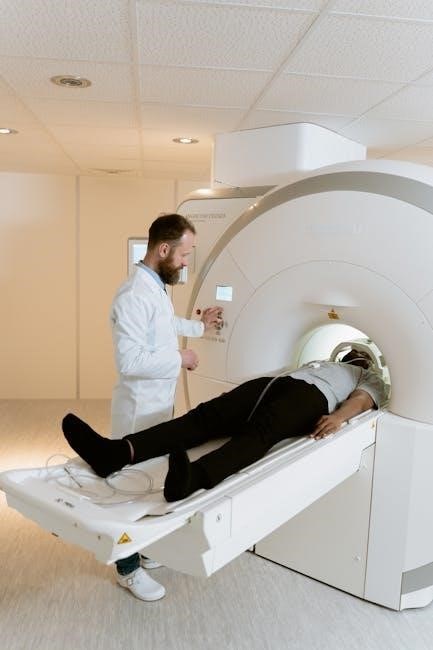The Conners Test is a widely used neuropsychological assessment tool for evaluating ADHD symptoms in individuals. It provides valuable insights into cognitive functioning and behavioral patterns‚ aiding in accurate diagnosis and monitoring. Available in versions like the Conners CPT and CAARS for adults‚ it is a cornerstone in clinical settings for understanding ADHD.
1.1 Overview of the Conners Test
The Conners Test is a comprehensive assessment tool designed to evaluate ADHD symptoms in individuals. It includes self-report and observer forms‚ assessing behaviors like inattention and hyperactivity. Widely used in clinical and research settings‚ it helps identify ADHD symptoms‚ monitor progress‚ and guide treatment. Its structured approach provides reliable data‚ making it a valuable resource for understanding ADHD across various populations.
1.2 Importance of the Conners Test in ADHD Diagnosis
The Conners Test plays a pivotal role in ADHD diagnosis by providing standardized‚ objective measures of symptoms. It helps clinicians identify attentional and behavioral issues‚ distinguish ADHD from other disorders‚ and monitor treatment effectiveness. Its reliability and comprehensive assessment domains make it an essential tool in both diagnostic and therapeutic processes‚ enhancing the accuracy of ADHD evaluations and management strategies.

Versions of the Conners Test
The Conners Test includes the CPT‚ CPT II‚ and Conners 3‚ each designed to assess ADHD symptoms in different settings. These versions evaluate attention‚ impulsivity‚ and hyperactivity‚ providing comprehensive insights for diagnosis and monitoring.
2.1 Conners CPT (Conners Continuous Performance Test)
The Conners CPT is a neuropsychological assessment tool designed to evaluate attention and impulse control in individuals with ADHD. It measures the ability to sustain focus and inhibit inappropriate responses through a computer-based task. The test is widely used in clinical settings to objectively assess cognitive functioning and behavioral patterns‚ providing valuable insights for diagnosis and treatment monitoring. Its results are often used alongside other assessments for a comprehensive evaluation.
2.2 Conners CPT II (Second Edition)
The Conners CPT II is an enhanced version of the original Continuous Performance Test‚ designed to improve the assessment of attention and impulse control in individuals with ADHD. It incorporates updated normative data‚ refined scoring algorithms‚ and expanded clinical applications. This edition enhances the test’s sensitivity and specificity‚ making it a more reliable tool for diagnosing and monitoring ADHD symptoms in both children and adults.

2.3 Conners 3 (Third Edition)
The Conners 3 is a multi-informant assessment tool designed to evaluate ADHD symptoms in individuals aged 6 to 18 years. It includes self-report‚ parent‚ and teacher forms‚ providing a comprehensive view of behavioral patterns. This edition incorporates updated norms and improved scales to better assess inattention‚ hyperactivity‚ and executive functioning. It is widely used for diagnosing ADHD and monitoring treatment effectiveness in clinical and educational settings.

Structure of the Conners Test
The Conners Test assesses ADHD symptoms through self-report and observer forms‚ evaluating domains like inattention‚ hyperactivity‚ and impulsivity. It provides a comprehensive framework for understanding behavioral patterns.
3.1 Self-Report and Observer Forms
The Conners Test includes self-report and observer forms to gather comprehensive insights into ADHD symptoms. Self-report forms allow individuals to assess their own behaviors‚ while observer forms‚ completed by parents‚ teachers‚ or clinicians‚ provide external perspectives. These forms evaluate domains such as inattention‚ hyperactivity‚ and impulsivity‚ offering a multi-informant approach for accurate assessment. The Conners 3 also includes parent‚ teacher‚ and self-report options‚ ensuring a well-rounded evaluation of symptoms and behaviors. These forms are available in PDF format for easy access and administration.

3.2 Assessment Domains (e.g.‚ Inattention‚ Hyperactivity)
The Conners Test evaluates key domains associated with ADHD‚ including inattention‚ hyperactivity‚ and impulsivity. These domains assess symptoms such as difficulty sustaining focus‚ impulsive behaviors‚ and excessive restlessness. The test also examines emotional distress and defiance‚ providing a comprehensive profile of ADHD-related behaviors. Each domain is scored based on severity‚ aiding in accurate diagnosis and treatment planning.
Scoring and Interpretation
The Conners Test uses T-scores‚ with higher scores indicating greater symptom severity. Scores above 70 suggest significant ADHD symptoms‚ aiding in accurate diagnosis and treatment planning.
4.1 T-Score Interpretation
T-scores in the Conners Test range from 50 (average) to 100 (severe symptoms). Scores above 70 indicate significant ADHD symptoms‚ while scores below 60 suggest minimal concerns. Interpretation guides clinicians in diagnosing severity levels‚ aiding in personalized treatment plans and monitoring progress over time.
4.2 Severity Levels of ADHD Symptoms
The Conners Test categorizes ADHD symptoms into severity levels‚ ranging from mild to severe. Mild symptoms may not significantly impact daily life‚ while moderate symptoms indicate noticeable challenges. Severe symptoms‚ often requiring immediate intervention‚ reflect significant impairment in functioning. These levels help clinicians understand symptom impact and guide appropriate treatment plans‚ ensuring personalized care for individuals with ADHD.
Clinical Applications
The Conners Test is essential for diagnosing ADHD‚ monitoring symptom progression‚ and guiding treatment plans. It helps clinicians assess behavioral changes and evaluate the effectiveness of interventions over time.
5.1 Diagnosis and Monitoring of ADHD
The Conners Test is a critical tool in diagnosing ADHD by assessing symptoms like inattention and hyperactivity. It also aids in monitoring treatment response and tracking symptom progression over time‚ allowing clinicians to adjust interventions effectively. The test’s standardized scales ensure reliable data collection‚ making it invaluable for both initial assessments and ongoing management of ADHD.
5.2 Use in Combination with Other Assessments
The Conners Test is often used alongside other diagnostic tools‚ such as the Vanderbilt Assessment Scale and clinical interviews‚ to ensure a comprehensive evaluation of ADHD symptoms. This multi-method approach enhances the accuracy of diagnosis and treatment planning‚ as it incorporates both objective and subjective data‚ providing a holistic understanding of an individual’s condition and needs.

Supplementary Tools and Resources
Supplementary tools like the Conners Adult ADHD Rating Scales (CAARS) and Vanderbilt Assessment Scale complement the test‚ offering comprehensive evaluation resources for ADHD assessment and management.
6.1 Conners Adult ADHD Rating Scales (CAARS)
The CAARS is designed for adults‚ providing self-report and observer forms to assess ADHD symptoms. It evaluates areas like inattention‚ hyperactivity‚ and impulsivity‚ offering insights into executive functioning and emotional regulation. This tool is crucial for diagnosing and monitoring ADHD in adults‚ complementing other Conners assessments for a comprehensive evaluation.
6.2 Vanderbilt Assessment Scale
The Vanderbilt Assessment Scale is a diagnostic tool used to evaluate ADHD symptoms in children and adults. It includes parent and teacher questionnaires to assess attention‚ hyperactivity‚ and impulsivity. The scale also evaluates impairment in daily functioning. Often used alongside the Conners Test‚ it provides a comprehensive view of ADHD symptoms‚ aiding in diagnosis and treatment planning.
Accessing the Conners Test Materials
Accessing Conners Test materials involves obtaining PDF versions and scoring sheets through licensed providers or publishers. Licensed professionals can acquire these resources for administration and interpretation‚ ensuring standardized assessment.

7.1 PDF Versions and Scoring Sheets
Conners Test materials‚ including PDF versions and scoring sheets‚ are accessible through licensed providers or publishers. These resources are essential for administering and interpreting the test accurately. Professionals can obtain these documents to evaluate ADHD symptoms effectively‚ ensuring reliable and standardized assessment processes for both children and adults.
7.2 Licensed Providers and Publishers
The Conners Test materials are distributed by licensed providers and publishers‚ ensuring authenticity and adherence to standardized protocols. MHS Assessments is a primary publisher‚ offering access to test manuals‚ scoring sheets‚ and forms through their official website or authorized distributors. Licensed professionals can administer and interpret the test accurately‚ maintaining the integrity of ADHD assessments.

Historical Context and Development
Developed by Keith Conners‚ the test emerged in the 1970s as a pivotal tool for ADHD assessment‚ revolutionizing understanding and diagnosis of the disorder through continuous refinement.
8.1 Keith Conners and the Evolution of the Test
Keith Conners‚ a renowned psychologist‚ pioneered the development of the Conners Test in the 1970s. Recognized as a leading authority on ADHD‚ he designed the test to objectively assess attentional deficits and hyperactivity. Over decades‚ Conners continuously refined the test‚ incorporating new research findings and clinical insights‚ ensuring it remains a reliable tool for diagnosing and monitoring ADHD across various age groups. His contributions have significantly influenced ADHD assessment practices globally‚ making the Conners Test a cornerstone in both clinical and research settings. The evolution of the test reflects Conners’ dedication to improving understanding and management of ADHD‚ adapting to changing diagnostic criteria‚ and addressing diverse patient needs. This ongoing development has solidified the test’s reputation as a comprehensive and essential evaluation instrument for ADHD symptoms.
8.2 Updates and Revisions Over Time
The Conners Test has undergone periodic revisions to enhance accuracy and relevance. Notable updates include the introduction of the Conners 3 in 2008‚ which incorporated improved normative data and expanded assessment domains. These revisions ensure alignment with evolving ADHD diagnostic criteria‚ providing a more comprehensive evaluation of symptoms and improving clinical utility for both children and adults.

Challenges and Limitations

The Conners Test faces challenges like subjectivity in ratings and cultural variability‚ which can impact accuracy. Ensuring consistent interpretations across diverse populations remains a key limitation.
9.1 Subjectivity in Ratings
The Conners Test relies on self-reporting and observer ratings‚ which can be subjective. Personal biases‚ varying perspectives‚ and differing interpretations of behaviors may lead to inconsistent scores. This subjectivity can affect the accuracy of ADHD assessments‚ emphasizing the need for skilled professionals to interpret results within a broader diagnostic context to ensure reliable outcomes.
9;2 Cultural and Individual Variability
Cultural and individual differences can influence Conners Test results‚ as behavioral norms and symptom expression vary across cultures. Additionally‚ personal experiences and perceived severity of ADHD symptoms may differ between raters‚ leading to variability in scores. While the test is comprehensive‚ it may not fully account for all cultural or individual differences‚ potentially impacting its universal applicability in diverse populations.
The Conners Test is a cornerstone in ADHD assessment‚ offering insights into symptoms and cognitive functioning. It’s widely used but often combined with other tools for comprehensive diagnosis. Future advancements may focus on improving its sensitivity to cultural and individual differences to enhance diagnostic accuracy.
10.1 Summary of the Conners Test’s Role in ADHD Assessment
The Conners Test plays a pivotal role in ADHD assessment by providing standardized measures of symptoms. It evaluates attention‚ hyperactivity‚ and impulsivity through self-reports‚ observer forms‚ and performance tasks. Widely used in clinical and research settings‚ it aids in diagnosis‚ monitoring‚ and treatment planning. Its multi-informant approach ensures a comprehensive understanding of ADHD manifestations‚ enhancing reliability and clinical utility.
10.2 Future Directions in ADHD Testing
Future advancements in ADHD testing may involve integrating digital tools and AI for more precise assessments. Combining objective measures like the Conners CPT with observational scales could enhance diagnostic accuracy. Additionally‚ developing culturally sensitive versions and expanding the use of multi-informant approaches will improve accessibility and reliability. These innovations aim to provide a more comprehensive understanding of ADHD‚ aiding in earlier and more accurate diagnoses.































